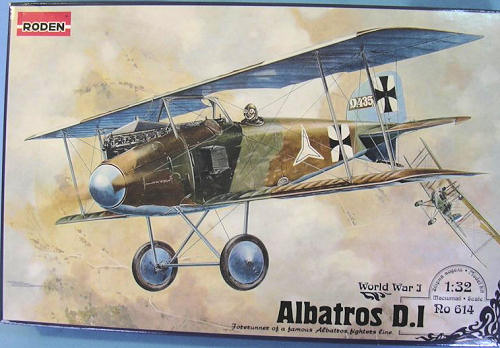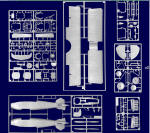
| KIT: | Roden 1/32 Albatros D.I |
| KIT #: | 614 |
| PRICE: | $64.99 MSRP |
| DECALS: | Four options |
| REVIEWER: | Tom Cleaver |
| NOTES: |

| HISTORY |
The Albatros series of fighters set the standard for a biplane fighter for the
following 20 years after their introduction, until the ascendance of the
all-metal monoplane.
The design set the standard for fighters ever after by
emphasizing speed and heavy armament, utilizing an inline liquid-cooled Mercedes
D.III engine of 165 h.p., and introducing two Spandau machine guns with an ample
ammunition capacity.
Unfortunately for Albatros, the German Air Force high command decided there was something intrinsically good in the sesquiplane layout utilized by the Nieuport 17, with the result that the sturdy biplane design of the first two versions was replaced by a sesquiplane design that was inherently exactly the wrong design for a fighter like the Albatros, which was heavy where the Nieuport was light, resulting in a fighter that with the introduction of the sesquiplane D.III and the following D.V forced its pilots to fight with one hand behind their back as they had to baby their fighters during air combat to avoid the possibility of catastrophic structural failure, where previously they had been able to throw the D.I and D.II about the sky with abandon.
| THE KIT |
 Roden brought out their 1/32 Albatros D.III a couple of years ago.
This kit
differs from that earlier kit by the substitution of the biplane wings and
bracing struts that were used by the D.I.
The fabric effect on these wings is excellent, providing
a very realistic look.
The fuselage - with is the same as the D.III - is fully
detailed with a cockpit and engine compartment, while the Spandau machine guns
and Mercedes engine are beautifully molded and detailed.
Roden brought out their 1/32 Albatros D.III a couple of years ago.
This kit
differs from that earlier kit by the substitution of the biplane wings and
bracing struts that were used by the D.I.
The fabric effect on these wings is excellent, providing
a very realistic look.
The fuselage - with is the same as the D.III - is fully
detailed with a cockpit and engine compartment, while the Spandau machine guns
and Mercedes engine are beautifully molded and detailed.

| CONCLUSIONS |
If you would like your product reviewed fairly and quickly, please contact me or see other details in the Note to Contributors.